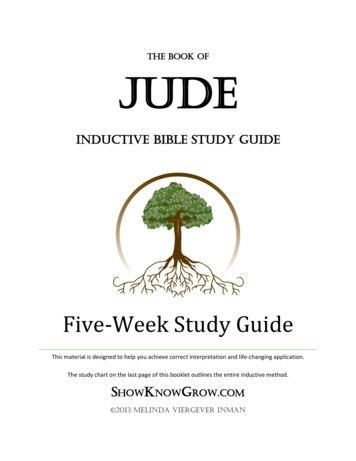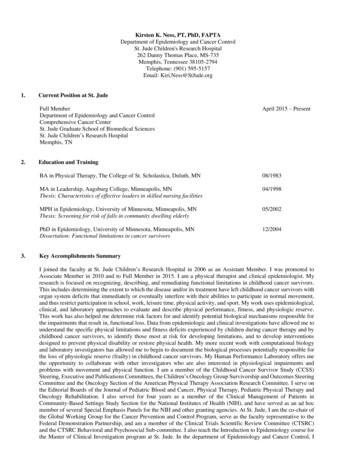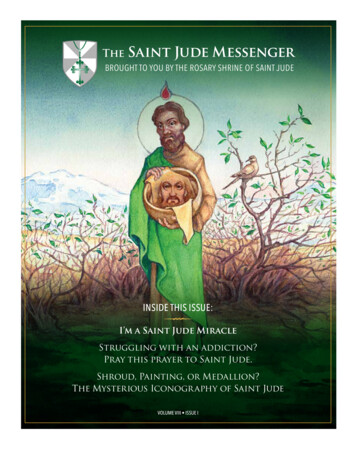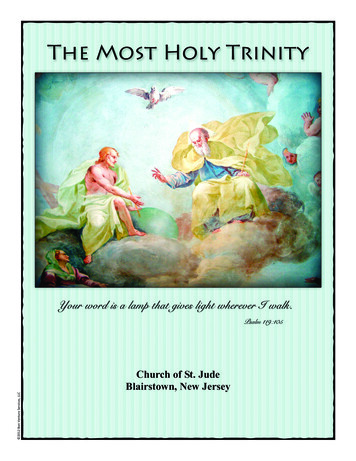
Transcription
The Book ofjudeinductive bible study guideFive-Week Study GuideThis material is designed to help you achieve correct interpretation and life-changing application.The study chart on the last page of this booklet outlines the entire inductive method.Showknowgrow.com 2013 Melinda Viergever Inman
Nuts and Bolts:Permissions: Scripture quotations marked (NIV ) are taken from the HOLY BIBLE, NEW INTERNATIONAL VERSION . NIV . Copyright 1973, 1978, 1984, 2011 by Biblica, Inc. . Used by permission. All rights reserved worldwide.Scripture quotations marked (ESV) are from the ESV Bible (The Holy Bible, English Standard Version ), copyright 2001 byCrossway Bibles, a publishing ministry of Good News Publishers. Used by permission. All rights reserved.Bibliography: Barker, Kenneth L. and John R. Kohlenberger III, The Expositor’s Bible Commentary, Abridged Edition, New Testament.Grand Rapids, Michigan: Zondervan, 1994.ESV Study Bible (The Holy Bible, English Standard Version ), copyright 2008 by Crossway, a publishing ministry of GoodNews Publishers. Used by permission. All rights reserved.Forgotten God published by David C Cook. Publisher permission required to reproduce any quotes and excerpts. All rightsare reserved.Hendricks, Howard G. & William D. Living by the Book. Chicago: Moody Publishers, 2007.Moo, Douglas J., The NIV Application Commentary: 2 Peter, Jude. Grand Rapids: Zondervan, 1996.Zodhiates, Spiros. The Complete Word Study Dictionary: New Testament (electronic ed). Chattanooga, TN: AMGPublishers, 2000, via Logos.Study OptionsEveryone studies in their own unique way. Therefore, there are several study options:1) If you prefer to work from one marked copy for the entire book, follow the stepsin “How to Build a Working Copy” to make one. Place it in a three-ring binder touse all the way through your study of the book. Then follow the guidelines in thismaterial, applying them to the working copy.2) If you don’t like the above option, the text is printed within this material;therefore, you can use this inductive Bible study guide alone. Additionally, theentire book is printed at the back to help you keep each section in context.3) If you prefer to mark your own Bible, simply refer to this material for studysuggestions and use it to record your observations.How to Prepare this MaterialPrint the material, so you can mark it up.Tactile, hands-on involvement is the idea.For ease of use and portability, this fiveweek study unit can be printed on 8 ½ x 11paper. Make two-sided copies on 3-holepunch paper, or make a stapled copy inbooklet form. This will place each day’sstudy on facing pages. The layout has beencarefully calibrated for this purpose. 2013 Melinda Viergever Inman/Jude Inductive Bible Study Guide/ShowKnowGrow.com2
Digging in: Observing, Interpreting & Applying JudeWhat do I see? What does it mean? How does it change me?How to approach your study: “Start with God’s Word; pray that the Spirit gives you clarity; then studyto see what the text actually says. The Holy Spirit inspired the writing of the Bible, so who better to helpus as we seek to understand it? Scripture tells us that the Spirit not only inspired the Bible, but alsoillumines it for us today (1 Cor. 2:12-16 and 2 Tim. 3:16) If we were to start with Scripture and allow it to dictate our actions, how would we live?”1The Goal:The fruit of an obedient and transformed life is the important thing, not task completion. Learning tolove the Savior more wholeheartedly and to apply His words is the goal.The study ideas suggested here are merely that—ideas. These study suggestions were developed tohelp YOU, personally, to comprehend and to apply God’s Word.The importance of careful, thorough Observation: “The more time you spend in observation, the lesstime you will need to spend in interpretation, and the more accurate will be your results. The less timeyou spend in observation, the more time you will need to spend in interpretation, and the less accuratewill be your results.”2 Slow down to SEE what God says.First, see pg. 85. Examine the chart of the Inductive Study Method.Now, plan the work. Work the plan. Here’s the strategy:Week One, pg. 5-12: The Overview will allow us to view the entire letter before we divide itup section by section to study. A thorough Overview helps us keep each section in contextwithin the letter and within the Bible as a whole. Three study options are detailed on page 2.Choose the one that will work best for your own study preferences.Weeks Two-Five: A five-day study is provided each week, dividing the letter into sections.Jude 1-4, pages 13-22, 76, 79Jude 5-10, pages 23-32, 76-77, 80Jude 11-16, pages 33-42, 77-78, 81Jude 17-25, pages 43-52, 78, 82Help pages, pg. 6, 53-75: Study Helps, Definitions, and Commentary included1Francis Chan, Forgotten God: Reversing our Tragic Neglect of the Holy Spirit, (Colorado Springs, CO: David C. Cook, 2009), pg. 23-24.Howard G. & William D. Hendricks, Living By the Book, (Chicago: Moody Publishers, 2007), pg. 43.2 2013 Melinda Viergever Inman/Jude Inductive Bible Study Guide/ShowKnowGrow.com3
Week One:OverviewBook of JudeMove at your own pace: Spread the Overview,pg. 5-12, over the course of this week 2013 Melinda Viergever Inman/Jude Inductive Bible Study Guide/ShowKnowGrow.com4
Tackling the Overview: The Game PlanWEEK 1, pg. 5-12, Observation: What do I see?Thorough Observation is the key to establishing context. Read. Reflect.The Plan this week: INVESTIGATE THE HISTORICAL BACKGROUNDHistorical/Biblical Setting: Where does this letter fit in the biblical timeline?Date of Jude:“Since Jude addresses a situation similar to that addressed by 2 Peter and exhibits a literary relationship(probably as a source) to 2 Peter, the two letters are commonly dated in fairly close proximity. (SeeIntroduction to 2 Peter: Author and Title below.) Therefore, while external evidence is sparse, Jude isbest dated in the mid-60s A.D.”3Date of 2 Peter:“Peter probably wrote this letter from Rome not too long before his martyrdom, sometime during A.D.64–67. Elements within the letter lead many scholars to conclude that Peter wrote during a time ofpersecution by Rome (perhaps during the persecution by Nero, who died in A.D. 68), while Peter himselfwas in a Roman prison awaiting imminent execution (cf. 1:12-15). The dating of the letter, then,depends largely on the dating of Peter’s death.”4Purpose, Occasion, and Background“Jude warns against following those who have surreptitiously gained entry to the church and areperverting the one true faith with false teaching. Indeed, the letter warns against allowing the falseteachers to continue to have influence. Jude calls the church to defend the truth aggressively againstthis infiltration. While the false teachers of Jude were profoundly libertine (morally unrestrained), itwould be anachronistic to argue that they were Gnostic (an early heretical sect, or group of sects,influential from the 2nd century A.D. onward).“Jude accomplishes his purpose by interpreting the OT analogically, using the same principles ofinterpretation found in 2 Peter (and elsewhere in the NT). He also draws on Jewish apocalyptictraditions (he refers to 1 Enoch and the Testament of Moses) in building his case. Thus, as literature,Jude has a distinctively Jewish flavor.“Given the apparent Jewish perspective of the letter itself, the audience of Jude is frequentlyidentified as Jewish, or as a mixture of Jewish and Gentile readers where the Gentiles are familiar withJewish traditions. However, any identification of the audience is largely conjecture.”53ESV Study Bible, (Wheaton, IL: Crossway, 2008), s.v. “Introduction to Jude,” “Date.”ESV Study Bible, (Wheaton, IL: Crossway, 2008), s.v. “Introduction to 2 Peter,” “Date.”5ESV Study Bible, (Wheaton, IL: Crossway, 2008), s.v. “Introduction to Jude,” “Theme,” “Purpose, Occasion, and Background.”4 2013 Melinda Viergever Inman/Jude Inductive Bible Study Guide/ShowKnowGrow.com5
Literary Features“The format is that of the NT epistle, with its loose divisions of salutation, body, and closing. But thecentral unit of the letter (vv. 5-16) falls decisively into the genre of a judgment oracle: it has an object ofattack, a many-sided vehicle in which the attack is embodied, a discernible harsh tone, and an impliedstandard by which the attack is being conducted (‘the faith that was once for all delivered to thesaints,’ v. 3). The description of the apostates (vv.8-16) uses the portrait technique in which, as onelearns more and more about the apostates, one finally has a picture of their character and actions. Theconcentrated use of images and allusions (e.g., to Sodom and Gomorrah and the archangel Michael)lends a poetic quality to the letter.“The writer displays horror over the spectacle of apostasy and the false teachers who induce it. Theonly NT passage that surpasses Jude in these traits is Jesus’ denunciation of the religious leaders inMatthew 23. But the letter begins with the usual soothing notes of NT epistles, and in the last twoverses it modulates into one of the most moving benedictions in the NT.”6Timeline7Good Bible study sources to aid your study: 67ESVonline.org requires site membership, but provides study tools, Greek and Hebrew lexicons,accompanying John Piper sermons, and a place for your own notes. All of this is onsite.The International Standard Bible Encyclopedia (ISBE), Eerdmans. Also available for free onlineat: http://www.Bible-history.com/isbe/.The New Unger’s Bible Dictionary, Moody Press.How to Read the Bible for All It’s Worth, by Fee & Stuart, Zondervan.Additional biblical research is also available free online at: www.Bible-history.com/.Free online Bible study sites: mystudybible.com, biblos.com, biblestudytools.com,Biblegateway.com, blueletterbible.com, and crosswalk.com.Commentaries: The Expositor’s Bible Commentary, Abridged Edition, Barker & KohlenbergerIII, Zondervan. The NIV Application Commentary: 2 Peter, Jude, Douglas J. Moo, Zondervan,1996. ESV Study Bible, Lane T. Dennis, Wayne Grudem, J.I. Packer, C. John Collins, Thomas R.Schreiner, Justin Taylor, Editors, Crossway Bibles, 2008.ESV Study Bible, (Wheaton, IL: Crossway, 2008), s.v. “Introduction to Jude: Literary Features.”ESV Study Bible, (Wheaton, IL: Crossway, 2008), s.v. “Introduction to Jude: Timeline” 2013 Melinda Viergever Inman/Jude Inductive Bible Study Guide/ShowKnowGrow.com6
First, read through the entire letter, pg. 83-84. Reflect on the tone.“Jude, a servant of Jesus Christ and a brother of James”: Who was Jude? Why was James?“As its title implies, the book was written by Jude, brother of James and Jesus (cf. Matt. 13:55; Mark 6:3, where Gk.‘Judas’ is the same as ‘Jude’ in Jude 1). There is little debate regarding the authenticity of the letter because of thestrength of internal evidence (e.g., v. 1). Some have claimed that an anonymous author wrote this using Jude’sname, but it is unlikely that any imposter would choose the name of such an insignificant figure for his writing.Also, such a pseudonymous work would have been rejected by the church (see Introduction to 1 Timothy: Authorand Title, esvonline.org), and Jude has been accepted as canonical from earliest times.”8eJude, Strong’s #2455. Ἰούδας Ioúdas; masc. proper noun transliterated from the Hebr. Y hūdāh (3063), confessorof Jehovah, praise. Judah or Judas (IV) Judas the brother of James. In two gospels (Matt. 13:55; Mark 6:3) James,Joseph, Simon, and Judas are named conjointly with the mother of Jesus as brothers of Jesus. In Jude 1:1, theauthor of that epistle is described as “Judas . . . the brother of James” (a.t.). The KJV has “Jude,” and in Mark 6:3,he is called “Judas.” These designations distinguish this Judas from the Jude (cf. III) who is described as “Judas theson of James” (a.t.), one of the Twelve Apostles. The confusion is the mistranslation of Iakṓbou (Judas) in Luke6:16 and Acts 1:13 as the brother of James (in the KJV) instead of his son (as in the NASB and the NIV). He who is abrother cannot also be a son. In Matt. 13:55, it is clearly stated that the two brothers, Judas and James, werealso the (note the def. art. hoi) brothers of Jesus. Of “Judas . . . the brother of James” (a.t.) as an individual weknow nothing, but account should be taken of what is said collectively of our Lord’s brothers. He was probably ason of Joseph and Mary, and thus a younger half–brother of Jesus. Judas misunderstood the popularity of Jesus(Matt. 12:46ff.). In his estimation, Jesus was a foolish enthusiast (Mark 3:21). Before the resurrection of Jesus, hedid not acknowledge his Brother as the Messiah (John 7:3ff.), but after the resurrection he is found “in prayer” inthe upper room (Acts 1:14); his doubts, like those of his brother James (1 Cor. 15:7), may have vanished in thepresence of the risen Lord. The distinct mention of the brothers of Jesus (Acts 1:13, 14) after the eleven have beennamed, is another reason for rejecting the KJV translation of Luke 6:16 which identifies Judas the apostle as thebrother of James He was the son of James and was also called Lebbaeus and Thaddaeus in Matt. 10:3 and Mark3:18 respectively. It also is further proof for the correctness of translating Ioúdas Iakṓbou in Luke 6:16 and Acts91:13 as “Judas the son of James” (as in the NASB and NIV) instead of “Judas the brother of James” (as the KJV).”James, 2385. Ἰάκωβος Iákōbos; or Iakṓb; Iakṓbou, masc. proper noun. James (IV) James the Lord’s brother (Matt.13:55; Mark 6:3), distinguished from the Twelve and particularly from James the son of Alphaeus (Matt. 10:3; John2:12; Acts 1:14 [cf. Matt. 12:47–50]). Other references to the Lord’s brothers are Matt. 12:46–50; Mark 3:31–35;Luke 8:19–21. During Christ’s ministry His brothers did not believe on Him (John 7:3–5), but later they werepresent with Mary and the apostles in an upper room (Acts 1:14). The following references outside the gospelshave to do with James: Acts 1:13, 14; 12:17; 21:18–25; 1 Cor. 15:7; Gal. 1:18, 19; 2:1–10. From these passages welearn that he was converted to a full acknowledgement of Christ (probably by the Resurrection), that the Lordappeared to him specially, that he became head of the Church of Jerusalem, and that he was put to death by theJews either just before the siege (Hegesippus) or some 10 years earlier (Josephus). He was surnamed the Just byhis fellow countrymen, and was greatly respected by all classes in Jerusalem. The Epistle of James is almostuniversally attributed to the brother of the Lord. This book is of greatest interest to students of the gospels.10There is no epistle which contains in a small compass so many allusions to Christ’s teachings.”8ESV Study Bible, (Wheaton, IL: Crossway, 2008), s.v. “Introduction to Jude: Author and Title.”Spiros Zodhiates, The Complete Word Study Dictionary: New Testament (electronic ed.), (Chattanooga, TN: AMG Publishers, 2000).10Spiros Zodhiates, The Complete Word Study Dictionary: New Testament (electronic ed.), (Chattanooga, TN: AMG Publishers, 2000).9 2013 Melinda Viergever Inman/Jude Inductive Bible Study Guide/ShowKnowGrow.com7
Judas (Jude) the brother of James. In two gospels (Matt. 13:55; Mark 6:3) James, Joseph, Simon, andJudas are named conjointly with the mother of Jesus as brothers of Jesus.5354Matt. 13:53-57 (NIV), When Jesus had finished these parables, he moved on from there. Coming to hishometown, he began teaching the people in their synagogue, and they were amazed. “Where did this man get this55wisdom and these miraculous powers?” they asked. “Isn’t this the carpenter’s son? Isn’t his mother’s name56Mary, and aren’t his brothers James, Joseph, Simon and Judas? Aren’t all his sisters with us? Where then did57this man get all these things?” And they took offense at him.12Mark 6:3 (NIV), Jesus left there and went to his hometown, accompanied by his disciples. When the Sabbathcame, he began to teach in the synagogue, and many who heard him were amazed. “Where did this man get thesethings?” they asked. “What’s this wisdom that has been given him? What are these remarkable miracles he is3performing? Isn’t this the carpenter? Isn’t this Mary’s son and the brother of James, Joseph, Judas and4Simon? Aren’t his sisters here with us?” And they took offense at him. Jesus said to them, “A prophet is not5without honor except in his own town, among his relatives and in his own home.” He could not do any miracles6there, except lay his hands on a few sick people and heal them. He was amazed at their lack of faith.During Jesus’ earthly ministry, Jude misunderstood his popularity (Matt. 12:46ff.).46Matthew 12:46-50 (NIV) While Jesus was still talking to the crowd, his mother and brothers stood outside,47wanting to speak to him. Someone told him, “Your mother and brothers are standing outside, wanting to speak4849to you.” He replied to him, “Who is my mother, and who are my brothers?” Pointing to his disciples, he50said, “Here are my mother and my brothers. For whoever does the will of my Father in heaven is my brother andsister and mother.”In Jude’s estimation, Jesus was a foolish enthusiast (Mark 3:21).20Mark 3:20-22 (NIV) Then Jesus entered a house, and again a crowd gathered, so that he and his disciples were21not even able to eat. When his family heard about this, they went to take charge of him, for they said, “He is out22of his mind.” And the teachers of the law who came down from Jerusalem said, “He is possessed by Beelzebul!By the prince of demons he is driving out demons.”Before the resurrection, he did not acknowledge his Brother as the Messiah (John 7:3ff.).1John 7:1-5 (NIV) After this, Jesus went around in Galilee. He did not want to go about in Judea because the Jewish23leaders there were looking for a way to kill him. But when the Jewish Festival of Tabernacles was near, Jesus’4brothers said to him, “Leave Galilee and go to Judea, so that your disciples there may see the works you do. Noone who wants to become a public figure acts in secret. Since you are doing these things, show yourself to the5world.” For even his own brothers did not believe in him.Jude’s doubts, like those of his brother James (1 Cor. 15:7), may have vanished in the presence of therisen Lord.11 Corinthians 15:1-7 (NIV) Now, brothers and sisters, I want to remind you of the gospel I preached to you, which2you received and on which you have taken your stand. By this gospel you are saved, if you hold firmly to the word3I preached to you. Otherwise, you have believed in vain. For what I received I passed on to you as of first4importance: that Christ died for our sins according to the Scriptures, that he was buried, that he was raised on the56third day according to the Scriptures, and that he appeared to Cephas, and then to the Twelve. After that, heappeared to more than five hundred of the brothers and sisters at the same time, most of whom are still living,7though some have fallen asleep. Then he appeared to James, then to all the apostles,Later, Jude says of Jesus: “Jesus Christ our only Sovereign and Lord” (Jude 4). 2013 Melinda Viergever Inman/Jude Inductive Bible Study Guide/ShowKnowGrow.com8
After the resurrection Jude is found “in prayer” in the upper room with Jesus’ other brothers (Acts 1:14):6Acts 1:6-14 (NIV) Then they gathered around him and asked him, “Lord, are you at this time going to restore thekingdom to Israel?”78He said to them: “It is not for you to know the times or dates the Father has set by his own authority. But youwill receive power when the Holy Spirit comes on you; and you will be my witnesses in Jerusalem, and in all Judeaand Samaria, and to the ends of the earth.”9After he said this, he was taken up before their very eyes, and a cloud hid him from their sight.10They were looking intently up into the sky as he was going, when suddenly two men dressed in white stood11beside them. “Men of Galilee,” they said, “why do you stand here looking into the sky? This same Jesus, who hasbeen taken from you into heaven, will come back in the same way you have seen him go into heaven.”12[c]Then the apostles returned to Jerusalem from the hill called the Mount of Olives, a Sabbath day’s walk from13the city. When they arrived, they went upstairs to the room where they were staying. Those present were Peter,John, James and Andrew; Philip and Thomas, Bartholomew and Matthew; James son of Alphaeus and Simon the14Zealot, and Judas son of James. They all joined together constantly in prayer, along with the women and Marythe mother of Jesus, and with his brothers.Timeline: these Scriptures are listed in chronological order, including time divisions in Acts. The gospels (written approx. A.D. 53-55, containing accounts of James, Jude, and Jesus’ other siblings)Acts 1:1-6:7, (A.D. 30/33, The apostles and Jesus’ brothers found Jerusalem church, persecuted/remain)Acts 6:8-11:26,(A.D. 33-38, Stephen, church scattered: Jude may have started his itinerant ministry)James (A.D. 40-45)Acts 11:27-14:28 (A.D. 39-44, Peter imprisoned, angel frees him, Peter leaves Jerusalem)Galatians (A.D. 48)Acts 15:1-18:171 Thessalonians &2 Thess. (A.D. 49-51)Acts 18:18-19:411 Corinthians (A.D.53-55)1Co. 9:5, Paul says Jesus’ brothers traveled with believing wivesActs 20:1-62 Corinthians (A.D. 55-56)Romans (A.D. 57) Acts 21:1-28:31 Ephesians (A.D. 62)Philemon (A.D. 62)Colossians (A.D. 62)Philippians (A.D. 62)1 Timothy (A.D. 62-64)Titus (A.D. 62-64)1 Peter (A.D. 62-64)2 Peter (A.D. 64-67)Jude (A.D. 64-67) 2 Timothy (A.D.64-67)The span of Jude (and his wife’s) ministry for Christ JesusJude’s only letter in the canon. May have used 2 Peter as a source.Read through the entire letter again. Reflect on how Jude speaks of Jesus. 2013 Melinda Viergever Inman/Jude Inductive Bible Study Guide/ShowKnowGrow.com9
Observation exercise: Noticing and marking the PersonsList everything you notice about the recipients:What kind of people are they? What commands and instructions did Jude give?1) Read through the entire letter at least once.2) As you read, jot down your observations in the space provided.3) If you’re using the working copy for the entire study, as you read mark in the working copy the wordsand pronouns associated with the recipients. Dear friends, love/loved, mercy, salvation/save,keep/kept/reserveList everything you notice about God, Jesus, and the Holy Spirit:1) Read through the entire letter at least once.2) As you read, jot down your observations in the space provided below.3) If you’re using the working copy for the entire study, as you read mark each member of the Trinity in aunique way in the working copy 2013 Melinda Viergever Inman/Jude Inductive Bible Study Guide/ShowKnowGrow.com10
List everything you notice about the “bad guys”:What kind of people are “these people”? What deeds? What mindset?1) Read through the entire letter at least once.2) As you read, jot down your observations in the space provided below and on the next page.1) If you’re using the working copy for the entire study, as you read mark in the working copy the wordsand pronouns associated with the “bad guys”: These people, perversion/evil desires/ immorality,keep/kept/reserve; condemn/judge; destroyed/fire/destruction/perishmindset terms, darkness/blackest, 2013 Melinda Viergever Inman/Jude Inductive Bible Study Guide/ShowKnowGrow.com11
Final Observation exercise: Ponder two Key Contrasting IdeasRead through the letter again as you record here what you observe about ace/Mercy 2013 Melinda Viergever Inman/Jude Inductive Bible Study Guide/ShowKnowGrow.com12
Week Two:One-Week Section StudyJude 1-4Plan the work. Work the plan. Here’s the strategy:The first 3 days provide different ways to observe the text.The fourth day is a long day of interpretation. The fifth day focuses on application.Work through all 5 days for the full study.Busy week? Adjust. Craft your own 3-day Study.Choose only one observation day—Day 1, 2, or 3, whichever one helps you the most.Then move on to days 4 and 5 for interpretation and application. 2013 Melinda Viergever Inman/Jude Inductive Bible Study Guide/ShowKnowGrow.com13
Day One, Focus on this:What do I see (Observation)? We’ll learn what it means later.Contemplate the text in at least two translations. Observe the details.Jude 1-4 (NIV )1 Jude, a servant of Jesus Christ and a brother of James,To those who have been called, who are loved in God the Father and kept for JesusChrist:2 Mercy, peace and love be yours in abundance.3 Dear friends, although I was very eager to write to you about the salvation weshare, I felt compelled to write and urge you to contend for the faith that was once forall entrusted to God’s holy people. 4 For certain individuals whose condemnation waswritten about long ago have secretly slipped in among you. They are ungodly people,who pervert the grace of our God into a license for immorality and deny Jesus Christour only Sovereign and Lord.First Steps: Establishing Context Read Jude 1-4 above and on the facing page. Reading a text in more than one translationgives us new insight. Compare the wording. Read acquisitively.Read through all of Jude to set this passage in context (pg. 83-84).Consider Jude 1-4 again. Write down the ideas you want to investigate further:Make notes in the margin of your working copy or in the text here.If you didn’t complete the Overview, take an extra day. Read through the letter again.Ponder what Jude says love, peace, mercy, and grace in contrast with what he says aboutdestruction, judgment, and punishment. Then summarize the aim of this letter:Make a traditional outline of the text, if it helps you. See a structural analysis outline, pg. 19. 2013 Melinda Viergever Inman/Jude Inductive Bible Study Guide/ShowKnowGrow.com14
Jude 1-4 (ESV )1Jude, a servant of Jesus Christ and brother of James,To those who are called, beloved in God the Father and kept for Jesus Christ:2May mercy, peace, and love be multiplied to you.3Beloved, although I was very eager to write to you about our common salvation, Ifound it necessary to write appealing to you to contend for the faith that was once forall delivered to the saints. 4 For certain people have crept in unnoticed who long agowere designated for this condemnation, ungodly people, who pervert the grace of ourGod into sensuality and deny our only Master and Lord, Jesus Christ.What do you see? Look at the text. In this step, we will observe, not interpret.1) Who wrote this letter? How does he describe himself?2) Think about it: What might it tell us about Jude that he calls himself a slave/servant of his older halfbrother Jesus, doesn’t spell out their family connection, and only names himself as a sibling of hismore well-known brother in the church, James? Has Jude been laboring outside the limelight?3) How does he describe the believers who received his letter, v.1? ,, andIf you are a believer, these three descriptions are also true of you. Pause to reflect on what eachof these might mean and on how these truths impact your daily life and your eternal destiny.4) What do the called receive, v.2?5) How are mercy, peace, and love given to those loved by God?6) What label does Jude attach to the recipients as v. 3 opens?7) What does this tell us with his relationship with the believers he addresses?8) What was he very eager to write about? But, what was hemore compelled to do?9) To whom was the faith once for all entrusted, v. 3?10) Why was Jude compelled? What had happened, v. 4a?11) Was their arrival overt or clandestine? How did they “slip in”?12) Was God surprised? What had God long ago inspired to be written about anddesignated would happen to these certain individuals?13) How are these people described in 4b? They are people,who and14) How does Jude describe his half-brother Jesus here? 2013 Melinda Viergever Inman/Jude Inductive Bible Study Guide/ShowKnowGrow.com15
Day Two, Key words:What does the text show me (Observation)?1) Read through Jude 1-4 thoughtfully one more time. Determine the key words andphrases for this particular section. A key word or phrase is one that is crucial tounderstanding the meaning of the text.2) So what words are crucial? Consider the questions you answered and meditated on frompg. 14-15. What words are crucial for comprehension? What words, if you removed themfrom the text, would remove the meaning or intent of the passage? What words tie thispassage to Jude’s overarching purpose and focus in this letter?3) Mark the words you now understand to be crucial—the words that have definitions youmust know in order to understand the text.HOW: Use color or pencil or ink, whichever you prefer. Mark each key word with a unique mark for thatparticular word (a different color for each key word, or a different way of circling it, or drawing a boxaround it, or any other creative mark you want to use for each particular word). The purpose of marking isto help us see what’s there. (1) If you are using the working copy you used to complete your Overview, youwill see that some of these words are marked already—words that are significant for the entire letter. (2) Ifyou’re not using the working copy, use the text on the facing page, or (3) complete this exercise in your ownbible. Or do any combination of the three; it’s entirely up to you.Mark these words with unique markings for each one: God, Christ Jesus, Holy Spirit Author (including pronouns [I, me, my, our], Jude) Recipients (including pronouns [you, your, those, who]), Dear friends Other people (including pronouns [their, they, themselves]), certain individuals, These people Key/Significant Words observed during the Overview: l
Jude has a distinctively Jewish flavor. Given the apparent Jewish perspective of the letter itself, the audience of Jude is frequently . Free online Bible study sites: mystudybible.com, biblos.com, biblestudytools.com,










